Edi Muka
Permanent Instability
We are approaching the end of a century that saw almost all sorts of human revolutions starting with technology ending up with the War, only to go back to technology that returns to War again. The last decade brought about also the triumph of the Western Capitalist Alternative versus Communism or its bastard forms, the tearing down of dividing walls and the reunification and liberation of people. Even so, the Balkan region seems to have remained trapped in some kind of suspension between Legend and Truth. The capability of generating self devastating conflicts apparently could not disappear even in the view of the actual and future technological progress that in the coming century "promised" a new future for humanity. This being trapped in some kind of endless transitional instability, seems to have turned this status-quo in the newest paradigm of socio-cultural developments.
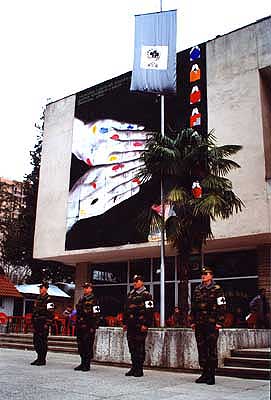 The
post 90's era is considered, or better said labelled as the Post Communist
era, and the territories that constitute it as Former Eastern Europe.
The first part of this label is a remnant of the Cold War terminology,
while the second one is a fresh and new nomination that is trying to "level"
the differences. Therefore it is interesting to consider that the actual
developments in the region with their insecure stability or with what
I would define as "Permanent Instability" puts a question mark to the
above ideological definitions. In a relatively wide geographical area,
where the condition of existence seems to be Instability, the transition
through an intermediate phase that never comes to crystallise a status
of Stability, has become a routine. What one can see as a consequence
is the replacement of chaotic situations, which include all spheres of
life alike, art and culture not excluded. The difference in this case
is that this Chaos is not just "another kind of order" as in the classical
Worringer's definition of order and chaos, but usually it is of a catastrophic
dimension. Therefore one can conclude that the preceding situation has
in some way worked to conceive this Chaos. But it is what follows that
completes the picture. What should be a time of
hope and change, is indeed made up of the same potential Chaos, thus preparing
the transformation of this "Post" into the consecutive "Pre". And to be
more explicit, all this referring to the region, means War and devastation.
On one hand such kind of analysis gives way to the conclusion that definitions
like "Post Communism" or "Former East", are essentially as ideological
as before. On the other hand, it shows that the ones that are inventing
them are not really interested in the consistency of their application
in the geographical or political territories, to whom they are addressed.
It is obvious that the change of situations from Pre into Post is not
something new for the history of mankind, especially not for this century.
But what is most striking is firstly its actual pace of changing from
one to the other, and secondly the outcome they produce, which makes this
process resemble a unceasing human frenzy.
The
post 90's era is considered, or better said labelled as the Post Communist
era, and the territories that constitute it as Former Eastern Europe.
The first part of this label is a remnant of the Cold War terminology,
while the second one is a fresh and new nomination that is trying to "level"
the differences. Therefore it is interesting to consider that the actual
developments in the region with their insecure stability or with what
I would define as "Permanent Instability" puts a question mark to the
above ideological definitions. In a relatively wide geographical area,
where the condition of existence seems to be Instability, the transition
through an intermediate phase that never comes to crystallise a status
of Stability, has become a routine. What one can see as a consequence
is the replacement of chaotic situations, which include all spheres of
life alike, art and culture not excluded. The difference in this case
is that this Chaos is not just "another kind of order" as in the classical
Worringer's definition of order and chaos, but usually it is of a catastrophic
dimension. Therefore one can conclude that the preceding situation has
in some way worked to conceive this Chaos. But it is what follows that
completes the picture. What should be a time of
hope and change, is indeed made up of the same potential Chaos, thus preparing
the transformation of this "Post" into the consecutive "Pre". And to be
more explicit, all this referring to the region, means War and devastation.
On one hand such kind of analysis gives way to the conclusion that definitions
like "Post Communism" or "Former East", are essentially as ideological
as before. On the other hand, it shows that the ones that are inventing
them are not really interested in the consistency of their application
in the geographical or political territories, to whom they are addressed.
It is obvious that the change of situations from Pre into Post is not
something new for the history of mankind, especially not for this century.
But what is most striking is firstly its actual pace of changing from
one to the other, and secondly the outcome they produce, which makes this
process resemble a unceasing human frenzy.
One of the reasons for this state of things is of course the perverted change of systems that happened after the failure of the previous one, let's call it Communism. What we got so far if we want to use Žižek's sexy definition is: "...a contradiction of the global capitalist New World Order at its most radical. The ideological dream of a unified Europe that aims at achieving the (impossible) balance between the two components: full integration in global market while retaining the specific national and ethnic identities. What we are getting in the Post-Communist Eastern Europe is a kind of negative, distopian realisation of this dream - in short, the worst of both worlds, unconstrained market combined with ideological fundamentalism."(1) In almost every country of the region a burst of nationalistic identity layers, mixed with historic and territorial claims appeared as soon as the heavy ideological wall was broken down. The immediate follow up of it was the formation of new authoritarian state structures or the explosion of fundamentalist nationalism, that in both cases generated conflicts of the highest danger - War. Therefore, what should have been understood under the fancy name Post Communism, could indeed be defined only as Pre War time. After a while this turned into Post War time, which as we have seen so far can easily turn into the consecutive Pre, and so on.
It is obvious though that the constant explosion of this historical, social and economical amalgam should not be ignored, especially from those who deal with Art and Culture. But there is also another very important issue for the definition of the artistic production at the end of the last decade. It has got to do with the fact that the entire above mentioned situation takes place in a time when there is a range of new phenomena showing in the artistic scene. This new phenomena is mostly conditioned by the same change of systems. This change of the aesthetic paradigm is present in different forms in almost every country in the region. In those countries with a relative ideological freedom, this change brought the legitimisation and the institutionalisation of certain artistic practices which were before considered as "politically non correct art" even though such tendencies had shown up already in the mid eighties. In other countries with a harder cultural and ideological repression, like Albania and maybe Romania or Turkey even, the appearance of such phenomena and their respective artistic practices happened in a relatively later time and found space and legitimacy only in the more recent years. The implied system change and the definitive triumph of capitalism was accompanied by the change of the aesthetic paradigm together with its positive and negative repercussions. I kind of stressed the "positive" and "negative" sides, because the application of the new aesthetic phenomena takes place in a specific or local environment, thus creating a new scene carrying with it important cultural potentials as well as consequences of superficial "adoption" of standards.
In numerous countries which we are talking about, the beginning of the 80's introduced the end of the rule of ideological art, or the so-called Socialist Realism. Despite this fact, everything that started to happen in art and culture took place in terms and practice of "underground culture", while in Albania cultural and ideological repression was at its climax. However, it was only the beginning of the last decade of this century that gave space and legitimised these movements, bringing in the new aesthetic post-modern paradigms together with its art forms. I think that the change of paradigm occurred because, together with the crumbling of the totalitarian system, its social, economical and aesthetic standards crashed as well. By the way, with this I do not mean that the new paradigm is not ideological at all, or that it does not belong to any system. Their differences consists of the fact that in face of the repressive nature of the former, the latter is raised upon a free personal base, the most important of which is, that it includes the possibility for acritical stance towards the very system that bears them. On the other hand, since their application takes place in totally differentcircumstances from their original ground the outcome can be as surprising as delicate. That is why the possibility that I was given to curate a show in Tirana, pushed me to a new adventure in the research of the artistic production of these territories that are officially known as the Balkans.
Therefore there are several key moments upon which Ibuilt my observation. First, the change of the aesthetic paradigm came into application according to the specifics of eachterritory. In some places it had already shown up and just legitimiseditself, while in other places it entered the scene immediately, and appeared from no tradition at all. But generally the immediate adoption was themain tendency towards it. As a consequence there was a rush of "new" art forms and practices in visual arts, which were in some places based upon the "underground" tradition, while in other places they were based on the intuitive research of new expression devices of individual artists (Albanian case).
Second, the legitimisation of this change was accompanied by an increasing interest of the cultural spheres of the West towards theircounterparts in the East. In the beginning this interest had an exotic shape, but afterwards it turned into some kind of a necessity, only to end up in the actual status of "marginal, emergent or peripheral cultures".
Third, technological progress and the advance of information and communication forms, together with the newest value crisis, broughtabout a lot of possibilities especially for those territories that were somehow prepared or in a more stable situation for it (Slovenian case).
I believe that it is in connection with these three moments, that artistic development took place, at least during the last decade of this century. The legitimisation of contemporary art practices, or of what had been called "politically non correct art", brought a new situation to the artistic production, which on its sidewas coming out of the mixture of very different fields like Art,Politics and War.
It was the reflection towards history or its recreation that occupied an important place in the creative process of many individuals or groups of artists. The impact of this mixture is strong and important, because it takes to a different outcome within the general structure of contemporary art. The show the curator of which I am, the project NSK Guard set up by the group IRWIN, refers directly to the above stance. The project I mention, is part of their in process State projects. Talking to the artists, I learned that this had come out in a protected exhibit of theirs in Bosnia. Therefore, the trip to Albania, known for its unrest and troubles during 1997, intrigued them to further develop the idea of the NSK Guard. The final project presented four real Albanian soldiers from the National Guard with the signs of the NSK protecting the raised flag of NSK with The Malevitch cross on it. Even though just by chance, the work was placed in a perfect context, since there was a rally in the street the very next morning, in which some people were yelling. Albanian soldiers with guns transfigured into the NSK Guard, with the NSK flag instead of the national flag, in the courtyard of the National Gallery, with some hundred people yelling in the street - it was almost perfect.
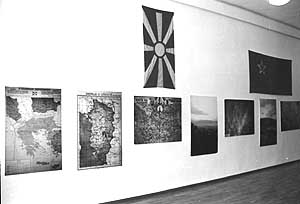 Another
interesting project called Portrait of the citizen of FYROM was
presented by two Macedonian artists, namely Aleksander Stankovski and
Branko Crkanjac. They presented a series of "ethnic nationalistic" maps,
withterritories according to different historical political plans for
"Big Serbia", "Big Albania", "Big Bulgaria" and so on. All of them seemed
to be a perfect computer animated manipulation, however, in fact they
were just enlarged sketches of original plans, which have historically
been an essential cause for devastating conflicts and genocide.
Another
interesting project called Portrait of the citizen of FYROM was
presented by two Macedonian artists, namely Aleksander Stankovski and
Branko Crkanjac. They presented a series of "ethnic nationalistic" maps,
withterritories according to different historical political plans for
"Big Serbia", "Big Albania", "Big Bulgaria" and so on. All of them seemed
to be a perfect computer animated manipulation, however, in fact they
were just enlarged sketches of original plans, which have historically
been an essential cause for devastating conflicts and genocide.
In an ironic way, Luchezar Boyadijev (Bulgaria) presented his project called See you, see me, see that tree. It was a real computer manipulation, used as a metaphor for history itself. In the hidden view, which could be seen only through spy holes there was an enlarged print from J. Cahlo, with a nude couple as Adam and Eve, but in a very relaxed posture, as if they were strolling down a beach and not amidst numerous dead bodies that were in the picture.
The other awarded work, presented by Alban Hajdini, a young and promisingAlbanian artist deals with the issues of war and fragmentation of the body. He exhibited both, photographs of some very idle kitsch scenes, referring to the everyday indifference, and as a contrast to this calmness, military boxes with wax casts of fragmented bodies. The piece was really strong and powerful and had an immediate impact on the viewer.
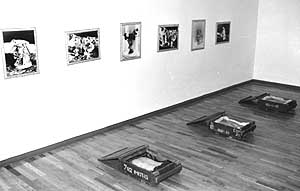 Some
interesting video art projects were also presented by several artists.
Adrian Paci (Albania) dealt with the instability of narration as a structural
point of the work. Using the simple narration of an old man and his little
daughter, where every character is taken from that world, the story in
itself is the trauma that the child has undergone during the events of
1997.
Some
interesting video art projects were also presented by several artists.
Adrian Paci (Albania) dealt with the instability of narration as a structural
point of the work. Using the simple narration of an old man and his little
daughter, where every character is taken from that world, the story in
itself is the trauma that the child has undergone during the events of
1997.
However, it is the little girl, with her story retold differently every time, that becomes the mediator and the object of the whole change. Another video art project was presented by Muhidin Tvico from Sarajevo. With a simple trick he avoids repetition by putting the washing machine process on top of the world events taken from different TV broadcasts. The other video installation entitled No more Heroes Anymore was presented by Marko Kovačič (Slovenia). There were many other projects presented by Žaneta Vangeli, Nebojša Šerić Šoba, Marina Gržinič, Gazmend Muka, as well as Edi Hila's paintings, etc., that deal with the social and political engagement of Art, with direct connotations to local references.
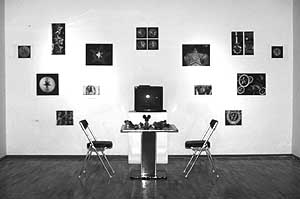
But on the other hand there were also projects that referred to the theme in a more intimate and metaphoric way. In this group I could cite the Turkish artist Selim Birsel, Pravdoliub Ivanov (Bulgaria) and his installation Transformation always takes time and energy, where 15 plugged electric pots heat water in large pans. However the water never boils. Flutura Preka and Besnik Haxhillari (Albania) also presented a strong performance called Gulliver's Sleep where both artists are laying vertically in a bed mounted very high on the wall, while Klod Agostini (Albania) presented another video installation about personal instability through an unconscious state such as sleep. Igor Grubić from Croatia also presented a personal approach to the theme through a conceptual photography triptych entitled Bridging the Interspace. In a very curious way, Lala-Meredith Vula (England/Kosovo) uses the positive, documentary glance of the Western ethnographic photography. Transforming men into objects, anthropology claims to be the study of the Other: Lala-Meredith Vula undermines this assumption and uses the very same instruments of anthropological analysis to describe her own Kosovo culture, working on the distance between empathy and the cold glance of documentation.
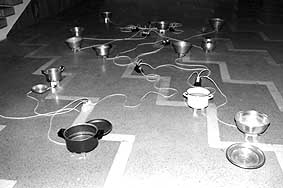
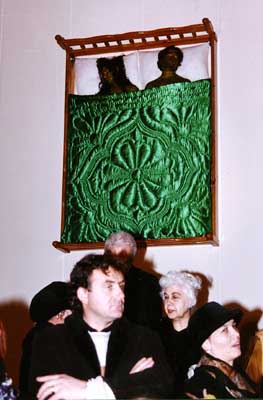 There
are many ways in which the new aesthetic paradigm has been adopted in
the artistic scene of many of the countries we are talking about. It is
true that besides the new dimensions revealed and the freedom obtained,
there is a considerable part of this artistic production that tempts to
simply imitate or repeat much of the Western Art. Up to a certain extent
this has to do with the fact that all this came from the West, therefore
it is legitimate or acceptable. But on the other hand this brought a lot
of superficial things, or "smart art" into the production. This has got
to do with catching some of the main tendencies of certain curators or
markets in the West whom indeed do not know the artistic scene or the
context of these territories.
There
are many ways in which the new aesthetic paradigm has been adopted in
the artistic scene of many of the countries we are talking about. It is
true that besides the new dimensions revealed and the freedom obtained,
there is a considerable part of this artistic production that tempts to
simply imitate or repeat much of the Western Art. Up to a certain extent
this has to do with the fact that all this came from the West, therefore
it is legitimate or acceptable. But on the other hand this brought a lot
of superficial things, or "smart art" into the production. This has got
to do with catching some of the main tendencies of certain curators or
markets in the West whom indeed do not know the artistic scene or the
context of these territories.
For example, this is strongly reflected in the denial or the ignoring of painting, at the same time as a painting revival is taking place in the big centres of art. On the other hand, after the initial tourist curiosity, the exchange between East and West now takes place within the frame of the newest process brought by the triumph of Capitalism - Globalism. This process is accompanied also by technological progress, at this I have in mind especially the advance of information and communication technologies, the expansion of new media and its impact on Art and Culture. The end of the century thus becomes just one more ingredient in the hot soup of cultural development. Even so, the "new freedom" for the artists, expected from the digital era, is still an illusion, since this digital era still exists within the frame of the same system, capitalism. Therefore, the change so far, is only one in the row of many changes the system allows, but it is not a radical one. However, all this does not mean that everything is locked up and therefore we should avoid it.
This situation reminds me of the technological progress at the beginning of the century. Thus, I think that the introduction of new aesthetic paradigms, technological advance, change of systems or even change of centuries, has opened up numerous possibilities for the potentials and the creative freedom of individual artists or artistic groups. The new situations brought surprising conclusions through the proceeding of the new standards. It is precisely here that local references become important in order to realise this proceeding. Only in that case artistic production shall avoid repetition or entering a closed cycle. Even with new aesthetic standards it is only through reference to the specific situation in which they are applied that makes a work of art worth being produced. This situation that was under my observation was reflected in the show Permanent Instability organised in Tirana last December. I also believe that Art has still something to say and for that it does not need only new mediums, but all mediums available. That is why I decided to set up a show where works from different disciplines communicate with each other through the message they are supposed to bring. Therefore, painting had the same importance as installation and video.
The fact that I decided to set up a show on the Balkan region should not be considered as an attempt to present regionalism as an alternative. I was simply intrigued by the mysterious layers, which during history produced as many meeting points as deadly conflicts, and I tried to summarise this fascination in the Permanent Instability concept. I believe that our different cultures have many points in common, and that we should try to use these points in order to bridge the communicative gap we have inherited. And since Tirana is a pure "periphery" I just grabbed the chance to benefit from the interest it might raise to do a trip there, a trip which we intend to turn into an annual international show.
Note:
(1) Slavoj Žižek, The Spector is Still Roaming Around, An Introduction to the 150th Anniversary Edition of the Communist Manifesto, Zagreb, Arkzin d.o.o., 1998, p.73